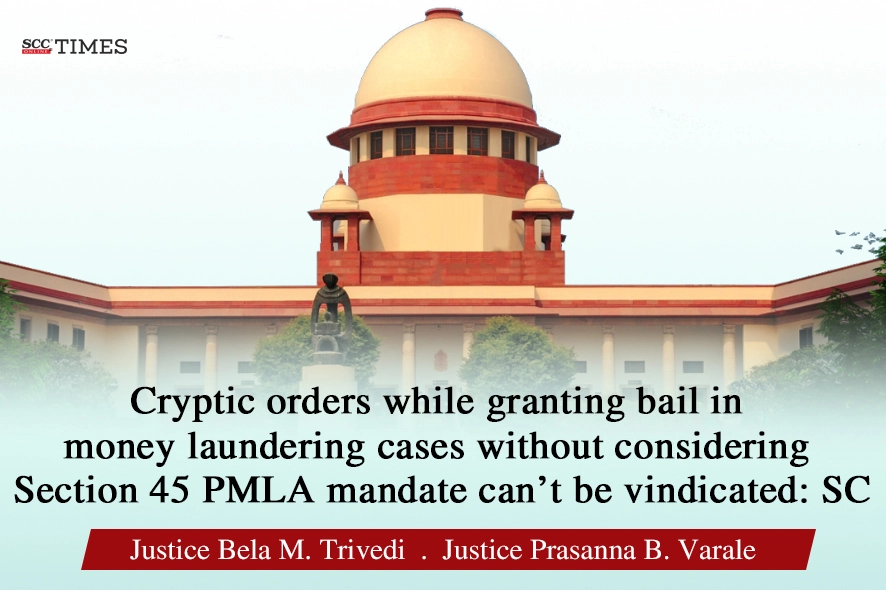Context
The Supreme Court has recently ruled on bail conditions under the Prevention of Money Laundering Act (PMLA), reinforcing its stringent provisions. This ruling overturned a Patna High Court decision that had granted bail to an accused in a money laundering case. The Supreme Court emphasized that the procedural standards under Section 45 of the PMLA were not followed, thereby asserting that the strict conditions for bail must be upheld.
Key Aspects of the Judgment
Bail under PMLA
- Section 45 of PMLA mandates strict conditions for granting bail.
- Courts must determine whether:
1. There is a reasonable belief that the accused is not guilty of the offence.
2. The accused is unlikely to commit further offences if granted bail.
- The Supreme Court reiterated that these conditions are mandatory and must be strictly followed to prevent unjustified bail approvals.
Discretion in Granting Bail
- The Patna High Court had granted bail to Kanhaiya Prasad due to prolonged imprisonment without trial.
- The Supreme Court criticized this decision, emphasizing that procedural delays cannot override the stringent conditions set by PMLA.
- The judgment reaffirmed that bail cannot be granted on procedural grounds alone, and the legal framework under PMLA must be adhered to.
 Understanding Money Laundering
Understanding Money Laundering
Money laundering is the process of concealing the origins of illegally obtained money, often through financial transactions involving foreign banks or legitimate businesses.
Stages of Money Laundering
1. Placement – Introducing illegal funds into the financial system.
o Breaking up large sums into smaller deposits.
o Depositing money into foreign/offshore banks.
o Purchasing high-value assets (art, jewelry, etc.).
2. Layering – Concealing the origins through complex transactions.
o Changing currency or transferring funds multiple times.
o Using shell companies to obscure ownership.
o Buying and selling assets to mask the source.
3. Integration – Injecting laundered money into the legitimate economy.
o Investing in real estate, businesses, or stock markets.
o Using fraudulent loans and invoices to justify transactions.
Impacts of Money Laundering
Security Threats
- Terror Financing – Used to fund terrorist activities.
- Example: The 26/11 Mumbai attacks were partially financed through laundered money.
- Organized Crime – Supports drug trafficking, human trafficking, and arms smuggling.
- Extremism – Fuels insurgencies and destabilizes national security.
Economic Consequences
- Disrupts Legitimate Businesses – Criminal front companies distort market competition.
- Financial Market Instability – Can cause liquidity crises in banks.
- Loss of Government Control – Illicit financial flows can outpace national budgets.
- Economic Distortion – Diverts funds from productive sectors to low-quality investments.
Social Impacts
- Encourages Crime – Strengthens criminal organizations and syndicates.
- Corrupts Institutions – Illegitimate funds allow criminals to influence politics and law enforcement.
- Undermines Public Trust – Weakens confidence in governance and financial institutions.
Anti-Money Laundering Measures in India
1. Prevention of Money Laundering Act, 2002 (PMLA) – Allows authorities to confiscate illicit assets.
2. Financial Intelligence Unit (FIU-IND) – Monitors and reports suspicious financial activities.
3. Enforcement Directorate (ED) – Investigates and prosecutes money laundering cases.
International Anti-Money Laundering Framework
1. Financial Action Task Force (FATF) – Sets global standards for anti-money laundering (AML).
2. United Nations Global Programme (GPML) – Assists nations in combating money laundering and terrorism financing.
3. UN Vienna Convention (1988) – Criminalizes money laundering and promotes international cooperation.
4. Asia/Pacific Group on Money Laundering (APG) – Encourages FATF compliance in the Asia-Pacific region.
5. Eurasian Group (EAG) – A regional alliance combating money laundering and terrorist financing.
Conclusion
The Supreme Court’s ruling reinforces the strict bail conditions under PMLA, ensuring that legal safeguards against money laundering remain intact. This decision is likely to impact future cases, emphasizing a balance between individual rights and the necessity of strong anti-money laundering measures.







